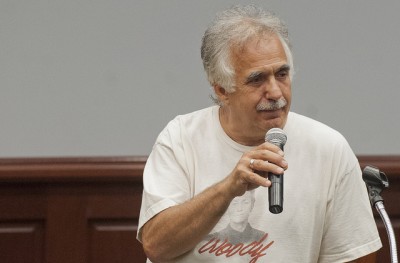Professor teaches course on the power of comedy and humor
By Bill ZimmermanJerry Zolten has researched humor and comedy for years — not a deep exploration of the physiological reaction that leads to a laugh, but rather what those chuckles say about us and the times we live in.

“It’s like pouring hot water on flowers if you get too serious about this,” said the associate professor of communication arts and sciences, and American studies at Penn State Altoona.
Nonetheless, Zolten’s course, “We Were What We Laughed At: A Cultural History Through Stand-up Comedy,” isn’t always a laughing matter, he said.
He begins the course with a look at the early days of American comedy when “it was mostly all about race and ethnicity” and some of the most persistent racial and ethnic stereotypes were born. He looks at how the post World War II years fostered a more communal spirit in comedy and how standups like Lenny Bruce and Dick Gregory would later use comedy to deliver social commentary on hypocrisy, racism and other ugly sides of American life.
“When you take a look at what we laughed at in our culture over a period of a 100 years, you really get a sense of who we were as a culture and how we’ve changed and how comedy works,” Zolten said.
Rooted in the pre-Civil War years and evolving well into the 1800s, minstrel shows featuring white performers in blackface mocking African-Americans in skits, dances and song, became the most popular form of comedic entertainment in America. According to Zolten, African-Americans would later perform in minstrel shows, donning blackface as well.
“If you were black and you wanted to work as an entertainer in those days you had to play the stereotype,” he said.
Vaudeville and burlesque would emerge in the late 1800s, supplanting minstrel shows, but those forms of entertainment still maintained humor full of racial and ethnic stereotypes. Jewish, Irish, German and Scottish Americans were among the targets. According to Zolten, the first record to sell a million copies was 1913’s “Cohen on the Telephone,” a comedic routine mocking Jews.
Stereotypes are still fodder for contemporary comedians, many of whom are telling jokes in a manner mocking racists that may not register with all listeners. With that, Zolten said, it sometimes creates confusion over what comedic boundaries people can cross in everyday life.
“Generally, you can make jokes about or poke fun at your own ethnicity to others of that ethnicity … and that’s OK,” he said. “Nobody gets bent out of shape, but if you are an outsider to an ethnicity and making fun of it to others who are also outsiders, then it can be painful to those who are targeted.”
He pointed to the experience of his friend and celebrated cartoonist R. Crumb, who has faced criticism for the way he drew minorities, but said Crumb’s intention was always to parody racism, exposing an ugly distortion in our cultural perception.
Despite the racist thread through comedy, Zolten said, the business also has a history of being quite democratic, open to women, Jews, blacks and other marginalized groups, as long as they could make people laugh. These comedians sometimes shattered misconceptions.
“That’s when comedy is at its best,” he said. “When it makes you think and rethink, shines a spotlight on social injustice, challenges prejudice, and maybe moves the culture beyond caricature and stereotype.”
Humor is just a slice of American pop culture of interest to Zolten. He’s also a music historian, specializing in American roots music. In 2003, he wrote “Great God A’Mighty! The Dixie Hummingbirds: Celebrating the Rise of Soul Gospel Music.” In August he organized Woody@100: Woody’s Legacy to Working Men and Women, a conference at University Park marking the 100th birthday of influential folk singer Woody Guthrie.
In the 200-level humor course, Zolten also gives a primer on the different types of comedy and notable practitioners. Among them: self-deprecating (Rodney Dangerfield), insult (Don Rickles), political (Jon Stewart) and observational (Jerry Seinfeld). They also look at the impact technology has had on standup — the advent of recordings and television meant comedians had to come up with new material more frequently — as well as the tendency for jokes to emerge in the wake of national tragedies. The course — to be offered next in fall 2013 — culminates in a non-graded assignment with students delivering three minutes of comedy — original or borrowed material.
“I want each of them to directly experience what it feels like to stand in front of people and try to make them laugh,” Zolten said.
Zolten, who for a year and half tried stand-up, said growing up in the Pittsburgh area he learned early about the power of humor, using it to win friends, defuse tense situations and defend against bullies. Part of his research has centered on comedians’ motivations, which he said can be quite varied. Some explore humor out of feelings of isolation, others see it as a way to flex intellectual muscles.
“People who make being funny part of their everyday social interaction, they sometimes kind of use it like radar,” he said. “You send out your signal and you see who responds positively, and you gravitate to them. But there is another side to it. Those who think they are funny but just come off being annoying and cloying. ‘I don’t want to hear that joke, jeez,’ and we avoid them. So, whether in personal life or on stage, there most definitely is an art to knowing how to be funny.”
- 1000 Batshit Crazy Ideas of a Very Stable Genius, #758: National Parks - March 6, 2025
- Welcome to the Museum of the Deep State - February 28, 2025
- Trump Unveils ‘Genius Plan’ to End Work, Taxes and Critical Thinking - February 28, 2025

